NORTH WALES COAST RAILWAY:NOTICE BOARD
Rheilffordd arfordir gogledd Cymru: Hysbysfwrdd
28 January 2019
Share on Twitter
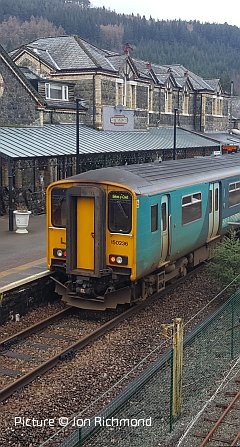
Tweets by @NWrail1
Contributions and comments are encouraged: see the Contributions Page
February 2019
Friday 1 February Clwyd Railway Circle “The Glorious Steam Railways of India” The images were taken when it was a fully steam worked system, with a variety of steam across four different gauges. John Sloane
Tuesday 5 February North Wales Railway Circle NWRC Secretary Peter Hanahoe will give 'A 1980s Extravaganza' slide-show.
Friday 8 February Altrincham Electric Railway Society Steam and Diesel in the Northern Fells 2010-2016. A digital presentation by Ian Pilkington.
Wednesday 6 February RCTS Liverpool "North West & North Wales Reminiscences of the 1960s" John Cashen
Monday 18 February RCTS Chester "A Taste of Japan" Gordon Davies
March 2019
Friday 1 March Clwyd Railway Circle “Annual General Meeting” followed by “Chairman’s Choice” A night of self indulgence from the retiring chairman, David Jones
Tuesday 5 March North Wales Railway Circle 'Next Train's Gone!'..Humph Davies with an illustrated historical survey of the route of the North Wales Narrow Gauge Railway & Successors, Part 1. Caernarfon -Rhyd Ddu.
Friday 8 March Altrincham Electric Railway Society. The Glorious Steam Railways of India. Steam across India from 1976 to the early 1980s. A digital presentation by John Sloane.
Monday 18 March RCTS Chester "55 Years of Railway Photography, Part 2" Les Nixon
April 2019
Tuesday 2 April North Wales Railway Circle Gareth Haulfryn Williams, archivist and author, on 'Rails to/from Bethesda.'
Wednesday 3 April RCTS Liverpool "Manchester to Liverpool by CLC" Ken Grainger
Friday 5 April Clwyd Railway Circle "Scotland in the 1960s" The talk covers the whole of Scotland - going up the west side to Wick and Thurso and returning down the east side from/to Carlisle.
John Cashen
Friday 12 April Altrincham Electric Railway Society Great Western and Southern Steam in the West Country. A colour slide presentation by Alf Storey.
Monday 15 April RCTS Chester "Steam on the North Wales Coast" (Video Presentation) Ron Watson Jones
May 2019
Tuesday 7 May North Wales Railway Circle AGM and Members' Photo. Competition.
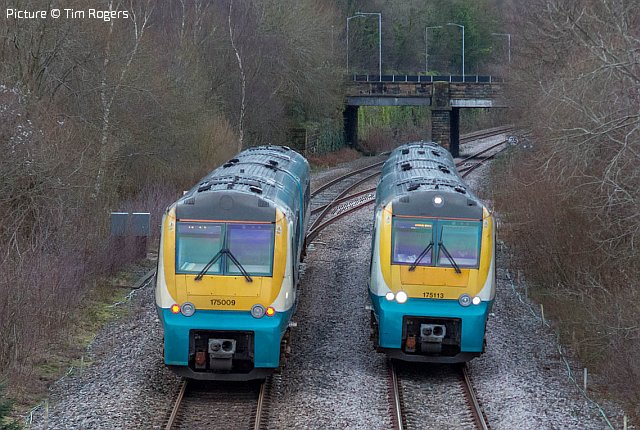
Mostyn on 25 January: 175 009 on 1D38 13:37 Manchester Airport to Llandudno meets 175 113 on 1H90 14:40 Llandudno to Manchester Piccadilly (Tim Rogers).
Red to silver 67
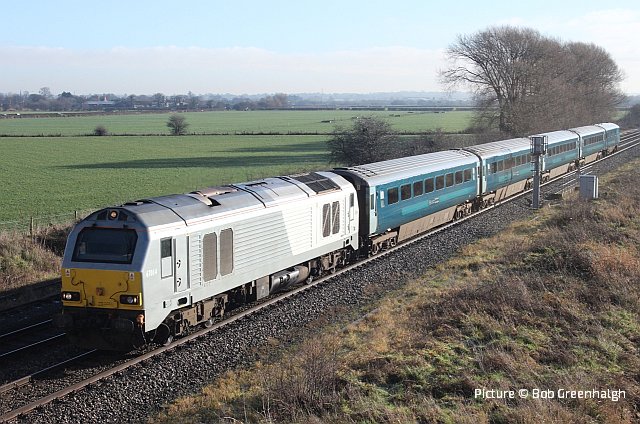
On 22 January the 09:50 Manchester - Holyhead, hauled by 67 020 as it had been for some weeks, was declared a failure at Newton--le-Williams station at 10:16. The passengers were de-trained, (what happened to them next?) and at 11:31 the train was re-started and travelled empty-stock to Warrington Bank Quay whence it was later taken to its stabling point at Crewe. The following train to North Wales was cancelled - the next westbound departure from Newton-le-Willows was the 11:37 Manchester Airport - Llandudno which was started from Manchester Piccadilly.
The following day, 23 January, a replacement loco was found in the shape of 67 014 (pictured above near Beeches Farm by Bob Greenhalgh), which retains its Wrexham and Shropshire livery, kept by Chiltern Trains after the closure of W &S., minus branding and the Shropshire-themed Thomas Telford nameplates. When Chiltern services were taken over by Class 68s, one nameplate from each of the four W & S 'namers' was sold in a GW Railwayana Auction in 2015 to raise money for charity. It sold for £3600; the highest price of the four was A Shropshire Lad from 67 012 which raised a remarkable £7,100.
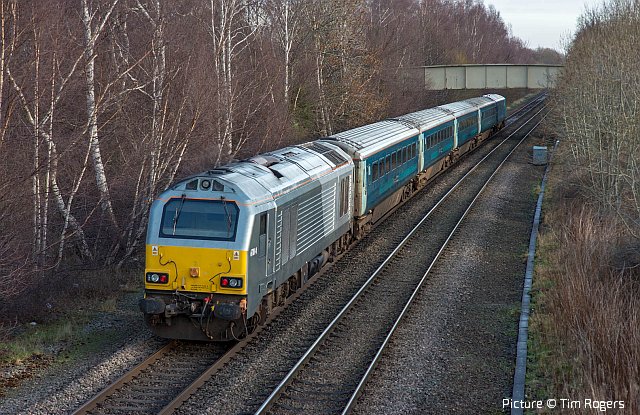
The return service, 1H89 13:07 Holyhead to Manchester Piccadilly, passes Shotton with 67 014 propelling from the rear. Driving van trailer 82308 was on the front as usual (Tim Rogers).
50 years apart - pictures by Peter Neve
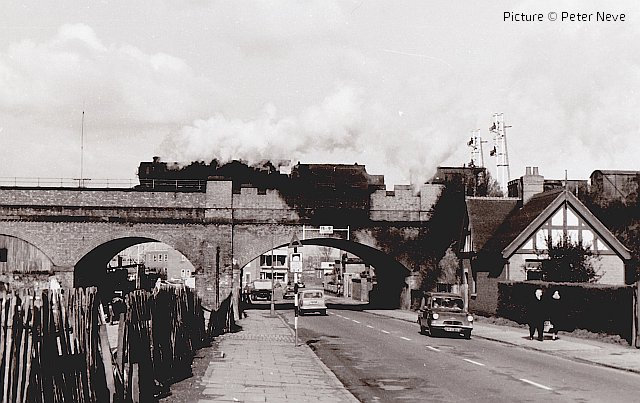
With a typical clank from the worn motion, Stanier 8F 2-8-0 48174 trundles a westbound freight over the castellated Chester Racecourse viaduct at New Crane Street, Chester on 29 March 1967. Note the semaphore signals on the two Up lines and the Ford Anglia van.
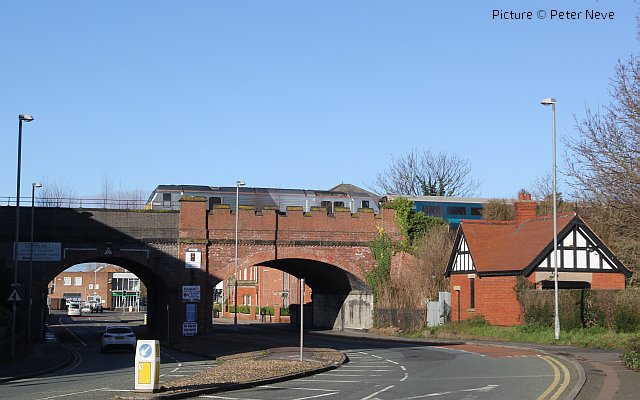
On 28 January 2019 67 014 hauls the 09:53 departure from Manchester Piccadilly (running as 1D34) to Holyhead at the same location. In the intervening years, the road has been re-aligned and converted to dual carriageway; the building, which is on the sports field of the Queen's School, has not altered at all.
Conwy Valley disruption
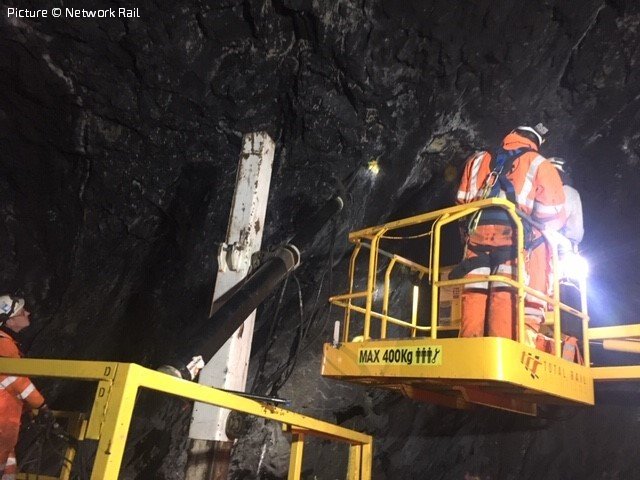
On 20 January fallen rocks were discovered inside of the long Ffestiniog Tunnel between Roman Bridge and Blaenau Ffestiniog, While Network Rail workers excavated the rock, installed netting and fixes 32 rock anchors to secure the remaining rock, the train service beyond Betws-y-Coed was suspended until 28 January.
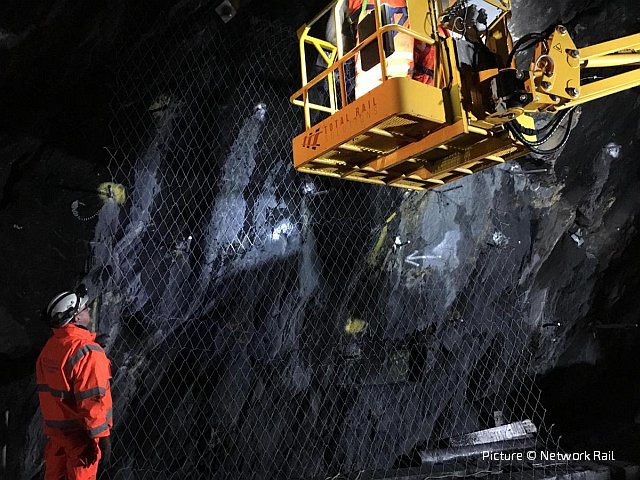
Network Rail have released these pictures of the work in progress; not easy in a single-track tunnel.
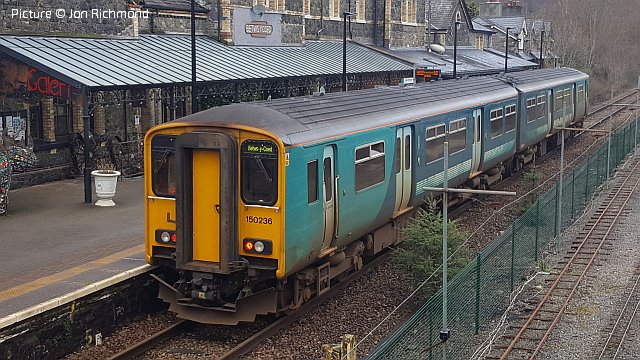
It's interesting that Betws-y-Coed acted as a terminus in this manner; we cannot recall this occurring in recent years, although the TfW Class 150s do feature it as a destination blind option, as Jon Richmond's view of 150 236 on 25 January shows. In the past, there were some trains which terminated here in the normal timetable. On the right are the tram and miniature-railway tracks of the Conwy Valley Railway Museum.
Britannia
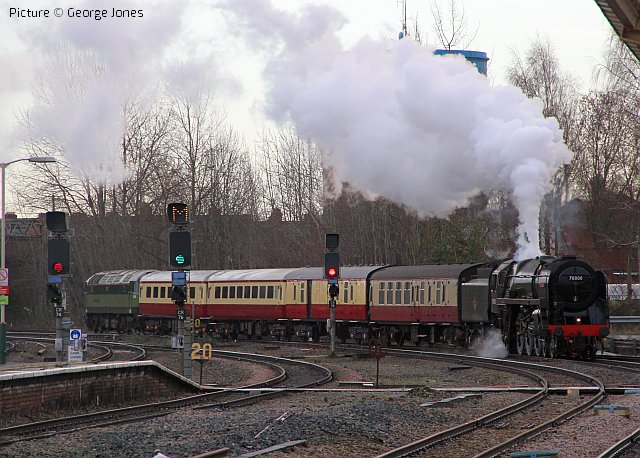
On 22-23 January Locomotive Services loco 70000 Britannia made loaded test runs from Crewe via Chester to Coton Hill sidings (Shrewsbury) and back, in fine but chilly weather. George Jones's picture shows the train running into Chester on 22 January, with Class 47 D1924 on the rear as 'insurance'.
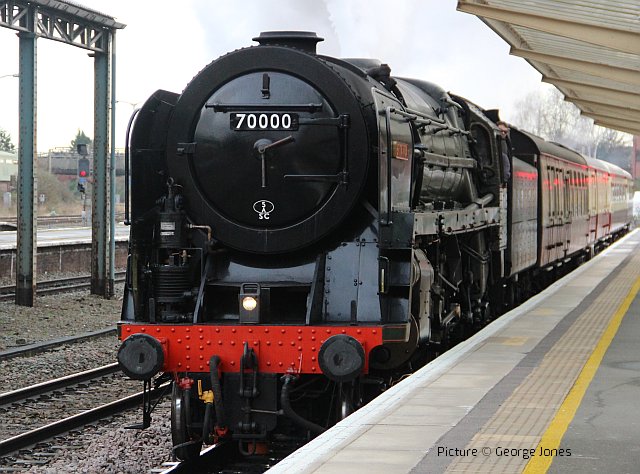
The train ran non-stop through Chester station (George Jones).
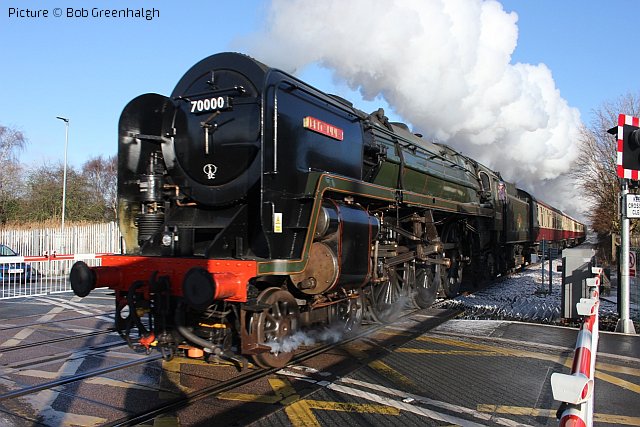
Bob Greenhalgh captured the train passing Green Lane crossing on 23 January.
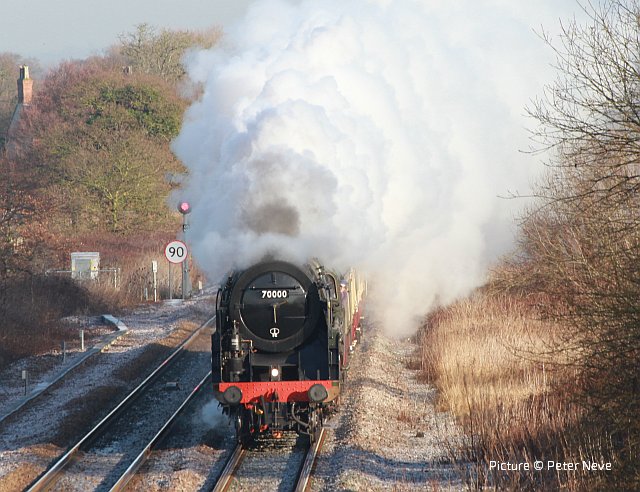
Above, the view from the footbridge on the approach to Rossett Junction on the Wednesday test run. Picture by Peter Neve, who notes: 'The freezing temperature produced an impressive exhaust trail in the bright winter sunshine. As ever, Britannia was in excellent mechanical condition and sounded like the proverbial “sewing machine”. The driver (wearing goggles) was on good form too, returning the customary wave.'
Llandudno Junction's Victorian-era changes - by Geraint Rowlands
In reference to the question posted in the 21 January issue regarding the date of the replacement curve to the Conwy Valley line, your reader will have noticed that Llandudno Junction station is depicted differently in the 1875-1878 and 1898-1899 Ordnance Survey versions. The original Llandudno Junction station (see the disused stations website) stood much nearer to Conwy, and was replaced with the current one in November 1897.
The location of this enlarged station necessitated the relocation of the connection with the Conwy Valley branch, hence the new loop of track that joined the main line near Glan-Morfa. An article in the Llandudno Advertiser dated 4 November 1897 about the opening of the new station says:
Consequent upon the altered position of the station, it was necessary to make a new branch line to join the Bettws-y-Coed line, about a mile from the station. This, and the widening of the line, was done by the company's own men. The work was commenced about twelve months ago, and considering its extent and the difficult nature of the site, it is considered that its completion has been rapid.The construction of the new station was contracted to Monk and Newell of Bootle. Unfortunately, the article is unclear whether the "twelve months" relate to the building of the station, the new branch, or the work as a whole. In order to build the new branch, the LNWR would have needed an Act of
Parliament to authorise the purchase of the land. This would normally be done in a general "LNWR Act" that covered numerous small changes all over their network. A search of the London Gazette shows that such a request was made during the 1895-1896 session, for:
Certain lands in the parish of Llangwstenin, lying on the south side of and adjoining the Company's Chester and Holyhead Railway, and between their Llandudno Junction Station, and a point 570 yards, or thereabouts, west of the bridge carrying the public road from Llansantffraid-Glan-Conway to Llandudno over the said railway.The bill had its third reading in May 1896, so after getting royal assent, work on the new line must have been done alongside the building of the new station in 1896-1897.
Looking back: Helsby 1980 - with Ken Millward
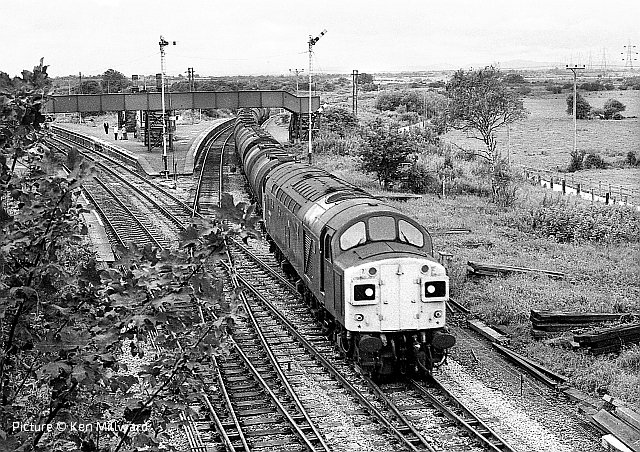
A visit to Helsby station on 5 May 1980. Above, 40 135 negotiates the junction with a tank train, probably from Stanlow refinery.
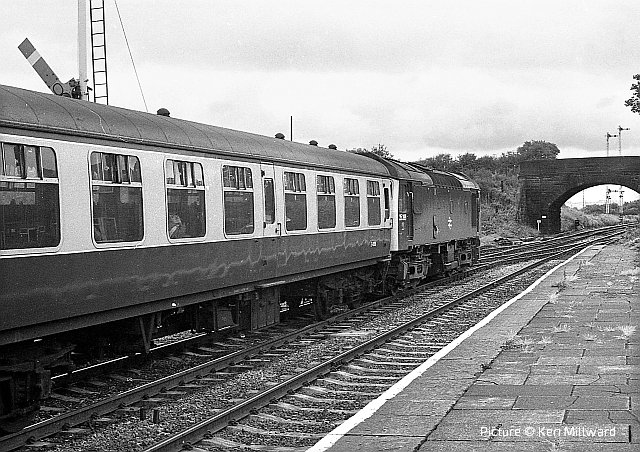
25 288 passes with a passenger train from North Wales to Manchester.
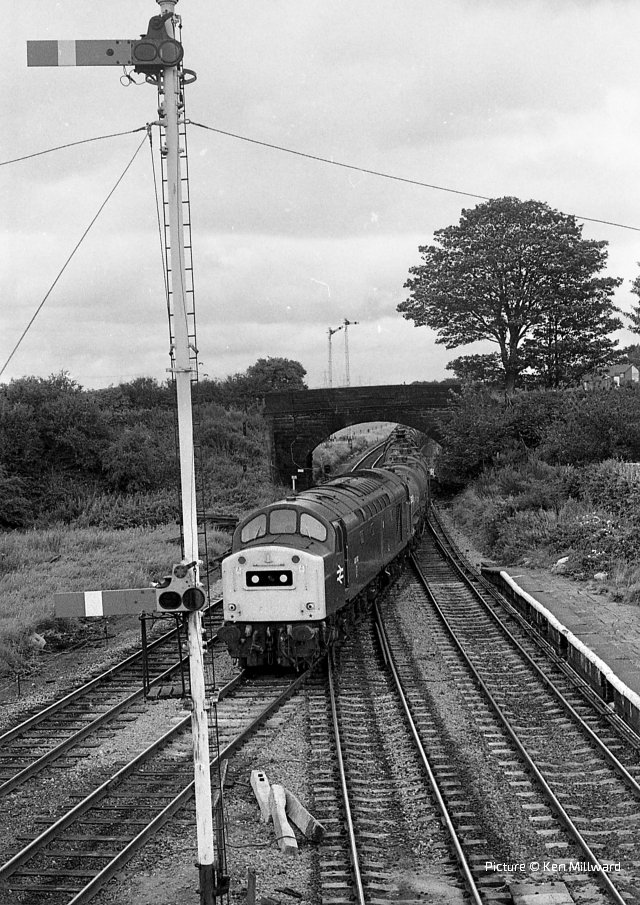
40 174 with a train of Caustic Soda tanks for the Rock Ferry line. The tall co-acting signals, provided because of sight-lines blocked by the bridge, dominate the scene.
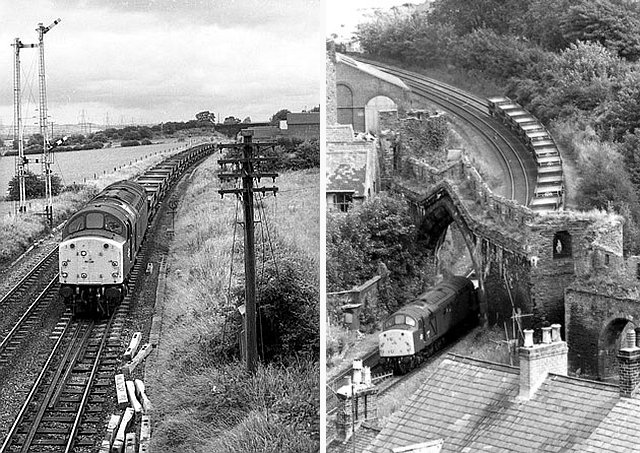
40 038 passes with a train of ballast hoppers heading for Penmaenmawr quarry (left). Two and a half hours later, I saw the same train again, passing through Conwy town walls (right).
Flasks - pictures by Tim Rogers
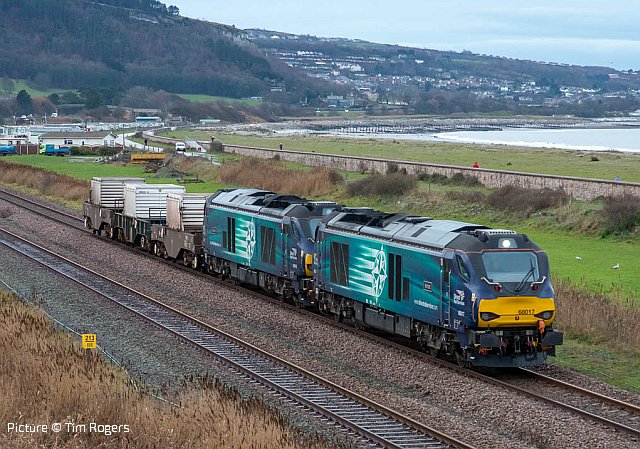
The race to complete the de-fuelling of Wylfa power station continues: on 23 January 68 017 Hornet & 68 016 Fearless pass milepost 213¾ near Abergele.
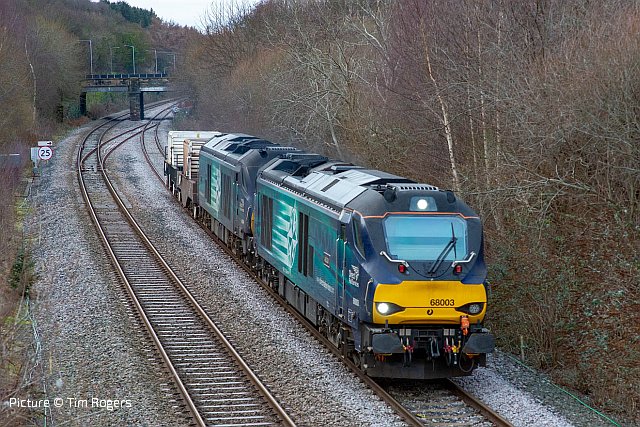
25 June near Mostyn: 68 003 Astute & 68 004 Rapid head for Crewe. The train also ran on Monday 21 January, so the 7-per-week quota continues...
Cheshire freight - pictures by Greg Mape
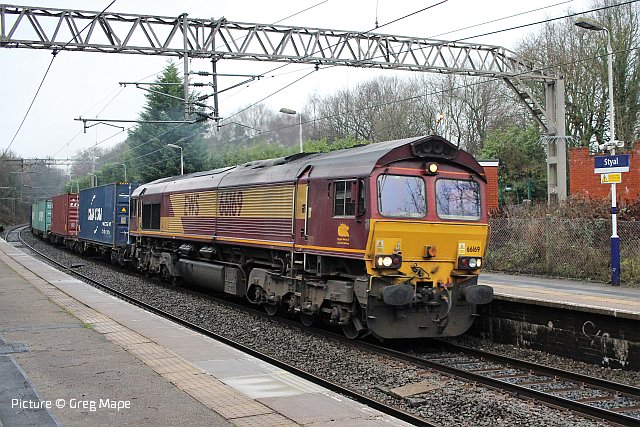
The rural station at Styal on 25 January, as 66 169 passes at 09:43 with the 09:12 Trafford Park Euroterminal to Southampton, a new service which is run by DB Cargo on behalf of logistics company UK Maritime Transport, who have also taken over the management of the Euroterminal. As the name suggests, this terminal was created to accept through traffic from Europe via the Channel Tunnel; will operators taken the opportunity to avoid the threatened lorry queues at Dover?
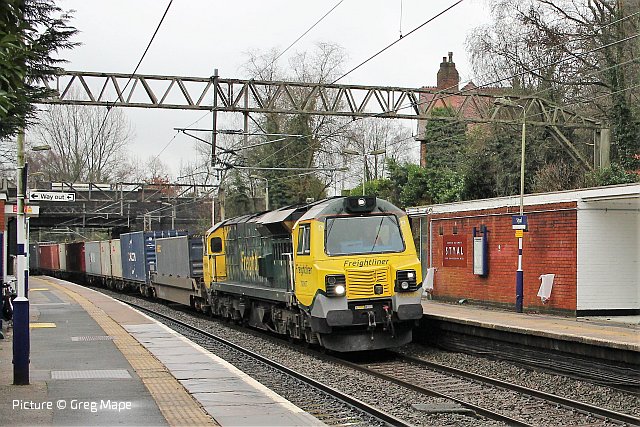
Ten minutes later, Freightliner 70 007 passes with the 03:44 Southampton Marine Container Terminal to Trafford Park.
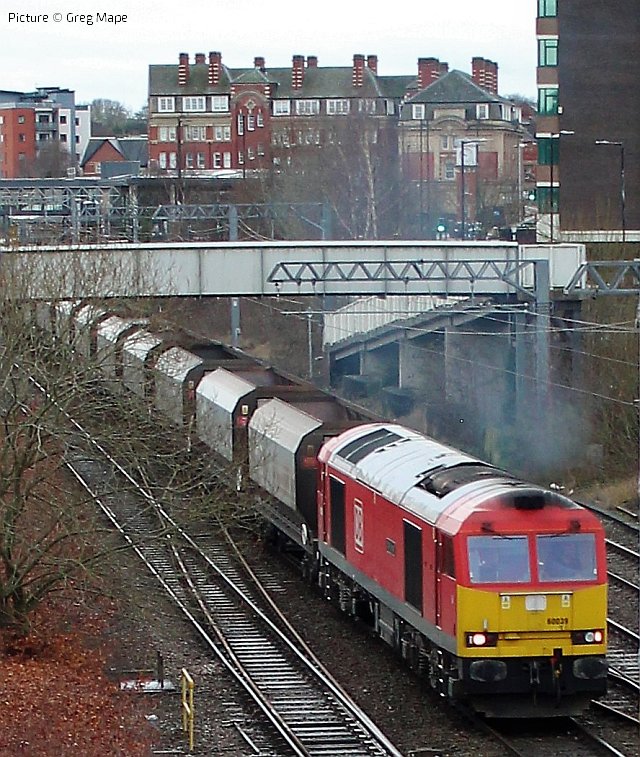
0n Sunday 27 January, 60 039 Dove Holes makes its way through Altrincham with Warrington Arpley - Tunstead empty stone hoppers. On the skyline is Stamford House, formerly called Station Buildings,designed by Charles Heathcote and finished in 1905, with the brick and stone banded details which are characteristic of the Edwardian period. Built as offices, it has recently been converted to apartments.
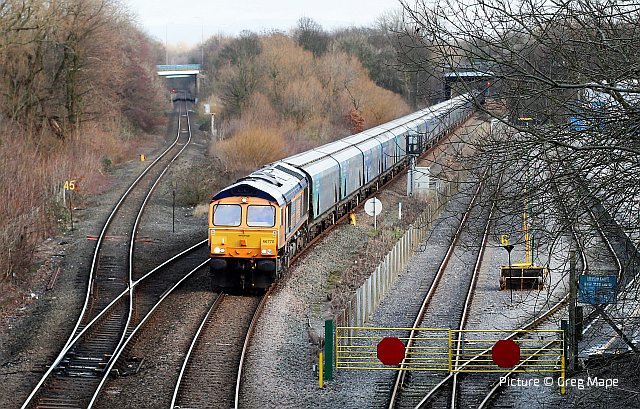
Northenden Junction, with the single-line towards Hazel Grove to the left, as 66 770 arrives from the Stockport direction with empty biomass wagons from Doncaster Decoy yard. The lines on the right serve the refuse terminal.
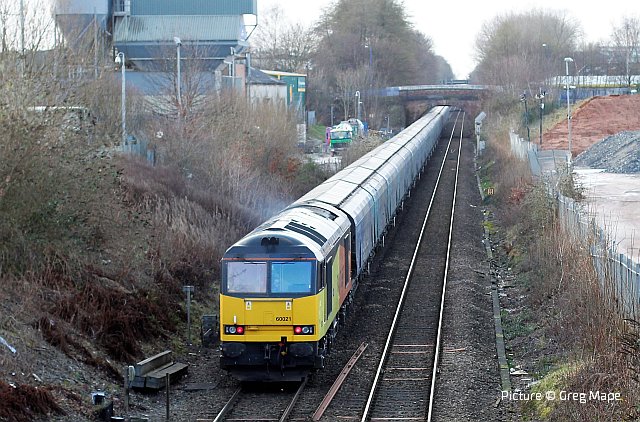
Unusually, on the rear was 60 021, in Colas colours but now owned by GB Railfreight. Equally unusually, perhaps due to enginnering work, the train had crossed the Pennines by the Standedge route rather than the Calder Valley line, possibly requiring a reversal en route.
North Wales Coast home page | Archive | Previous Notice Board